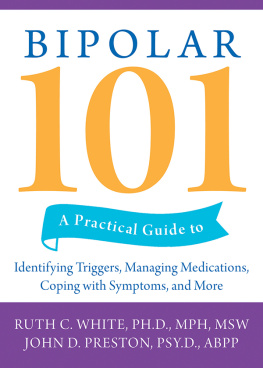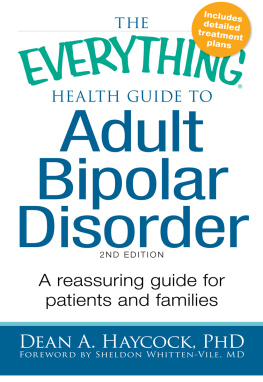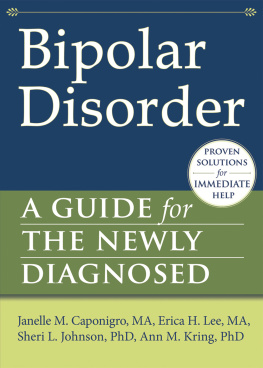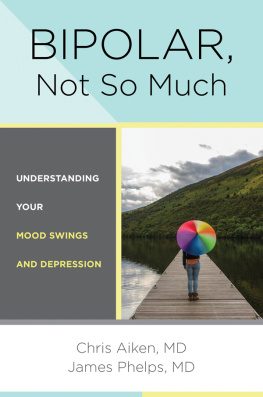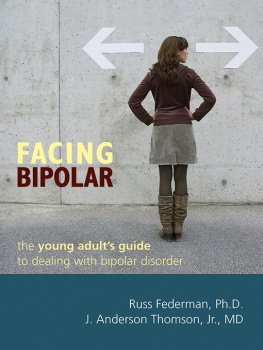BIPOLAR DISORDER
A JOHNS HOPKINS PRESS HEALTH BOOK
FRANCIS MARK MONDIMORE, M.D.
Bipolar Disorder
A Guide for Patients and Families
Second Edition

NOTE TO THE READER. This book is not meant to substitute for medical care of people with bipolar disorder or depression, and treatment should not be based solely on its contents. Nor is it meant to offer legal advice, which must be obtained from a practicing attorney.
1999, 2006 Francis Mark Mondimore
All rights reserved. Published 2006
Printed in the United States of America on acid-free paper
9 8 7 6 5 4 3 2 1
The Johns Hopkins University Press
2715 North Charles Street
Baltimore, Maryland 21218-4363
www.press.jhu.edu
LIBRARY OF CONGRESS CATALOGING-IN-PUBLICATION DATA
Mondimore, Francis Mark, 1953
Bipolar disorder : a guide for patients and families / Francis Mark Mondimore. 2nd ed. p.; cm.
Includes bibliographical references and index.
ISBN 0-8018-8313-X (alk. paper) ISBN 0-8018-8314-8 (pbk.: alk. paper).
1. Manic-depressive illnessPopular works. 2. Affective disordersPopular works. I. Title.
[DNLM: 1. Bipolar DisorderPopular Works. 2. Bipolar DisordertherapyPopular Works. WM 207 M741b 2006]
RC516.M64 2006
616.89 5DC22 2005021215
A catalog record for this book is available from the British Library.
Figures by Jacqueline Schaffer
Contents
Preface
About 2 percent of the population suffers from some form of bipolar disorder. Winston Churchill, George Frederick Handel, Lord Byron, Virginia Woolf, Edgar Allan Poe, Napoleon Bonaparte, and Vincent van Gogh are only a few of the politicians, writers, artists, and musicians who, despite having bipolar disorder, left a mark of greatness upon the world. Most persons who are affected by this illness, however, are ordinary people who want nothing more than to get back to their everyday lives after they or their family members have been diagnosed with it. This book is written for them.
We psychiatrists have at times become a little complacent about this disease. When lithium became widely available in the United States in the mid-1970s, many psychiatrists thought that the battle to control the illness had been won. Indeed, lithium wasand still isa miracle drug for many of those who suffer from what was then known as manic-depression. More recent studies, however, indicate that a substantial proportion of patients have a relapse of their illness despite taking lithiumaccording to some studies, as many as half. But even as we become more aware of the sobering facts about the difficulty of successfully treating this illness, an explosion of developments in science and medicine is occurring that holds great promise for those affected by the disease. In this book I shall relate this good news.
Clinical research has shown again and again that many relapses of bipolar disorder occur not because of medication failure, but rather because patients stop taking medication and drop out of treatment. Perhaps patients dont understand that relapse and repetition of illness episodes are the hallmark of the illness, that abruptly stopping medication has been shown to be especially risky, that medication side effects can often be treated or controlled, and that new medications are becoming available all the time. I hope this book helps those who face difficult treatment decisions to make well-informed and intelligent choices.
A survey of patients with bipolar disorder and other mood disorders done by the National Depressive and Manic-Depressive Association in the early 1990s found that 36 percent of those who responded to the questionnaire did not seek professional treatment until more than ten years after their symptoms began. Seventy-three percent of the bipolar patients in this study had received at least one incorrect diagnosis before being identified as having bipolar disorderoften many years after they had first sought help. The average respondent had seen 3.3 physicians before being correctly diagnosed. Why is this illness so difficult to identify correctly? One reason is that full-blown manic-depressive illness is only one of the several forms this chameleon disorder can takeand may in fact be less common than the milder forms (the so-called soft bipolar disorders). We are realizing that many patients with these milder forms of the disorder benefit from treatment with mood-stabilizing medications, too. But they can do so only if treatment is sought and the correct diagnosis is made. We shall see why many patients who have a bipolar disorder are labeled neurotic or receive a diagnosis of a personality disorder. Another purpose of this book is to spread the word that symptoms of mild depression and subtle mood swings may be the only manifestations of a mild form of bipolar disorder that can be effectively treated.
Like any other serious illness, bipolar disorder affects not only the person who suffers from the disease but family, friends, and colleagues as well. Family support is crucial to the effective management of symptoms. The disrupted relationships and interpersonal conflicts that the symptoms of the illness can cause make bipolar disorder all the more difficult and complicated to treat. Information and understanding are part of the treatment for this disease too, and this book was written not only with the patient in mind but for his or her family and friends as well.
Bipolar disorder can be a fatal disease. Although the figures vary among studies, about 15 percent of persons with bipolar disorder commit suicide; many more make suicide attempts. These are preventable deaths, because very effective treatments for this illness exist. I hope that the information this book provides about the treatment of bipolar disorder addresses some of the reasons why individuals are reluctant to enter treatment and dissuades some from stopping treatment against medical advice. Yes, it is my hope that this book will save lives.
Acknowledgments
I wish to thank those who have contributed to this project. Thanks to Robert Bright, M.D., Charles Casat, M.D., Rhonda Crow, Caroline Gretick, Sallie Mink of the Depression and Related Affective Disorders Association (DRADA) at Johns Hopkins, and Jenny Rosenthal of the Public Library of Charlotte and Mecklenburg County, who reviewed the manuscript and provided valuable feedback and much-needed encouragement.
Thanks to Jacqueline Schaffer for her handsome illustrations and to the staff of the Alan Mason Chesney Medical Archives at Johns Hopkins for the portrait of Dr. Adolf Meyer.
Special thanks to all the talented and dedicated staff of the Johns Hopkins University Press, who have been such a pleasure to work with on this as well as on my previous projects. Thanks is a flimsy word indeed to express my sincere and deep appreciation for the editorial skills and constant encouragement of my editor, Jacqueline Wehmueller.
Thanks, as well, to Jay Allen Rubin for countless cups of tea and for putting up with so many hours of a closed office door at home.
PART I
SYMPTOMS, SYNDROMES, AND DIAGNOSIS
A former professor of mine once told me, When you cant figure out what the patient has, he or she probably has bipolar disorder. I remember thinking at the time that this was one of the most foolish things I had ever heard a Johns Hopkins faculty member say. But over the years I have come to realize that he was right (and also to realize that you dont get appointed to the faculty at Johns Hopkins by saying foolish things).
Next page

